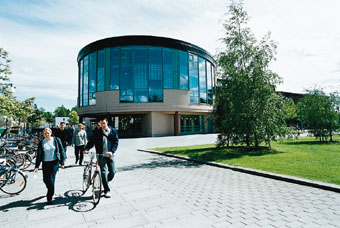Campus Örebro
Campus Örebro

In addition to the library, this building houses study rooms, research rooms, a cafeteria and a large auditorium.
Generally
In order to obtain good air quality in the premises, the ventilation is adapted to the number of people and the equipment planned for the rooms. To provide heat and prevent frostbite, there are radiators located along facade walls.
Office
The air supply in offices takes place automatically with a continuous flow. The temperature can be regulated manually via a room regulator on the wall by the door, turning the switch towards plus makes it warmer and turning it towards minus makes it colder.
Meeting room
In meeting rooms, the ventilation can be forced manually via a push button on the wall. The temperature can be regulated manually via a room regulator on the wall by the door, turning the switch towards plus makes it warmer and turning it towards minus makes it colder.
Extended operating time
After regular office hours, i.e. in the evening and on weekends, the ventilation in the building is switched off to save energy. The ventilation can be started manually again via push buttons marked with blue signs in the corridors.
Car parking
Parking spaces intended for vehicles with a handicap permit are available next to the house.
Entrances and lifts
The entrances are accessible and all floors can be reached via lift.
RWC and rest room
Toilets adapted for the disabled are available on each floor. In rest rooms and at the RWC there are security alarms with red push buttons labeled "emergency signal". Alarms are indicated locally by sound and a red flashing light outside each room. It is important that you who see and hear this alarm contact the person concerned who needs help.
SCARED - WARN - ALARM - EXTINGUISH
• save yourself and others around you, but don't take too many risks yourself
• warn others who may be in danger
• alert the Emergency Services by calling 112
• put out the fire if possible
Automatic fire alarm
Evacuation alarms in case of fire are triggered via smoke detectors placed in escape routes, technical spaces and in spaces where many people gather. Triggered alarm, i.e. signal to evacuate, given via bell and red flashing lights in parts of the house.
Triggered alarms go to SOS and Akademiska Hus. Fires that cannot be extinguished with deployed hand fire extinguishers must be called via telephone 112. Limit the source of the fire by closing windows and doors.
You can manually trigger the evacuation alarm using push buttons in connection with the escape routes.
Fire cells
The building is divided into a number of fire cells to prevent fire and smoke from spreading.
Each fire cell is delimited by fire-rated walls and doors. In principle, all floors, stairwells, lifts, operating areas and waste rooms have their own fire cells. Doors in fire compartment boundaries can be magnetically suspended in the open position for transport and closed manually with a push button marked "fire door closer". When an evacuation alarm is triggered, the doors close automatically within the alarmed area.
Doors in fire cell boundaries must absolutely not be blocked by wedges or the like!
Escape routes / Assembly point
See evacuation plans in corridors.
The stairwells form independent escape routes. Two stairwells can be reached from each workplace. The escape routes, which are marked with green luminous escape signs, must never be blocked. The green signs are always lit and have a battery backup to illuminate even in the event of a power cut.
If the fire alarm is triggered, all personnel must leave the building, close all doors behind them and gather at the assembly point (See the respective evacuation plan).
Offices and workplaces
Lighting is switched on and off via a pull switch in the fixture and/or a switch at the door.
Group room
The lighting is switched on manually via a push button.
Other spaces
The lighting is controlled by the KNX system, switched on and off via panel.
Lighting in toilets is controlled locally with motion detectors or manually via a push button.
AV equipment
For questions regarding AV equipment, contact the University's AV technician in the IT department.
Örebro University is responsible and takes care of all waste management.